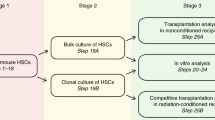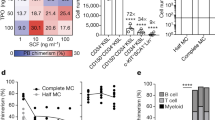Abstract
Successful ex vivo expansion of hematopoietic stem cells (HSCs) would greatly benefit the treatment of disease and the understanding of crucial questions of stem cell biology. Here we show, using microarray studies, that the HSC-supportive mouse fetal liver CD3+ cells specifically express the proteins angiopoietin-like 2 (Angptl2) and angiopoietin-like 3 (Angptl3). We observed a 24- or 30-fold net expansion of long-term HSCs by reconstitution analysis when we cultured highly enriched HSCs for 10 days in the presence of Angptl2 or Angptl3 together with saturating levels of other growth factors. The coiled-coil domain of Angptl2 was capable of stimulating expansion of HSCs. Furthermore, angiopoietin-like 5, angiopoietin-like 7 and microfibril-associated glycoprotein 4 also supported expansion of HSCs in culture.
This is a preview of subscription content, access via your institution
Access options
Subscribe to this journal
Receive 12 print issues and online access
$209.00 per year
only $17.42 per issue
Buy this article
- Purchase on Springer Link
- Instant access to full article PDF
Prices may be subject to local taxes which are calculated during checkout





Similar content being viewed by others
References
Shizuru, J.A., Negrin, R.S. & Weissman, I.L. Hematopoietic stem and progenitor cells: clinical and preclinical regeneration of the hematolymphoid system. Annu. Rev. Med. 56, 509–538 (2005).
Verma, I.M. & Weitzman, M.D. Gene therapy: twenty-first century medicine. Annu. Rev. Biochem 74, 711–738 (2005).
Sauvageau, G., Iscove, N.N. & Humphries, R.K. In vitro and in vivo expansion of hematopoietic stem cells. Oncogene 23, 7223–7232 (2004).
Sorrentino, B.P. Clinical strategies for expansion of haematopoietic stem cells. Nat. Rev. Immunol. 4, 878–888 (2004).
Krosl, J. et al. In vitro expansion of hematopoietic stem cells by recombinant TAT-HOXB4 protein. Nat. Med. 9, 1428–1432 (2003).
Willert, K. et al. Wnt proteins are lipid-modified and can act as stem cell growth factors. Nature 423, 448–452 (2003).
Moore, K.A., Ema, H. & Lemischka, I.R. In vitro maintenance of highly purified, transplantable hematopoietic stem cells. Blood 89, 4337–4347 (1997).
Fraser, C.C., Eaves, C.J., Szilvassy, S.J. & Humphries, R.K. Expansion in vitro of retrovirally marked totipotent hematopoietic stem cells. Blood 76, 1071–1076 (1990).
Miller, C.L. & Eaves, C.J. Expansion in vitro of adult murine hematopoietic stem cells with transplantable lympho-myeloid reconstituting ability. Proc. Natl. Acad. Sci. USA 94, 13648–13653 (1997).
Varnum-Finney, B. et al. Pluripotent, cytokine-dependent, hematopoietic stem cells are immortalized by constitutive Notch1 signaling. Nat. Med. 6, 1278–1281 (2000).
Antonchuk, J., Sauvageau, G. & Humphries, R.K. HOXB4-induced expansion of adult hematopoietic stem cells ex vivo. Cell 109, 39–45 (2002).
Reya, T. et al. A role for Wnt signalling in self-renewal of haematopoietic stem cells. Nature 423, 409–414 (2003).
Zhang, C.C. & Lodish, H.F. Insulin-like growth factor 2 expressed in a novel fetal liver cell population is a growth factor for hematopoietic stem cells. Blood 103, 2513–2521 (2004).
Zhang, C.C. & Lodish, H.F. Murine hematopoietic stem cells change their surface phenotype during ex vivo expansion. Blood 105, 4314–4320 (2005).
Kim, I. et al. Molecular cloning, expression, and characterization of angiopoietin-related protein. angiopoietin-related protein induces endothelial cell sprouting. J. Biol. Chem. 274, 26523–26528 (1999).
Conklin, D. et al. Identification of a mammalian angiopoietin-related protein expressed specifically in liver. Genomics 62, 477–482 (1999).
Camargo, F.D., Green, R., Capetanaki, Y., Jackson, K.A. & Goodell, M.A. Single hematopoietic stem cells generate skeletal muscle through myeloid intermediates. Nat. Med. 9, 1520–1527 (2003).
Oike, Y., Yasunaga, K. & Suda, T. Angiopoietin-related/angiopoietin-like proteins regulate angiogenesis. Int. J. Hematol. 80, 21–28 (2004).
Yoon, J.C. et al. Peroxisome proliferator-activated receptor gamma target gene encoding a novel angiopoietin-related protein associated with adipose differentiation. Mol. Cell. Biol. 20, 5343–5349 (2000).
Zeng, L. et al. Identification of a novel human angiopoietin-like gene expressed mainly in heart. J. Hum. Genet. 48, 159–162 (2003).
Peek, R., van Gelderen, B.E., Bruinenberg, M. & Kijlstra, A. Molecular cloning of a new angiopoietinlike factor from the human cornea. Invest. Ophthalmol. Vis. Sci. 39, 1782–1788 (1998).
Zhao, Z. et al. The gene for a human microfibril-associated glycoprotein is commonly deleted in Smith-Magenis syndrome patients. Hum. Mol. Genet. 4, 589–597 (1995).
Yamamoto, T. et al. Molecular cloning and initial characterization of a novel fibrinogen-related gene, HFREP-1. Biochem. Biophys. Res. Commun. 193, 681–687 (1993).
Arai, F. et al. Tie2/Angiopoietin-1 signaling regulates hematopoietic stem cell quiescence in the bone marrow niche. Cell 118, 149–161 (2004).
Oike, Y. et al. Angiopoietin-related growth factor antagonizes obesity and insulin resistance. Nat. Med. 11, 400–408 (2005).
Li, C.L. & Johnson, G.R. Stem cell factor enhances the survival but not the self-renewal of murine hematopoietic long-term repopulating cells. Blood 84, 408–414 (1994).
de Haan, G. et al. In vitro generation of long-term repopulating hematopoietic stem cells by fibroblast growth factor-1. Dev. Cell 4, 241–251 (2003).
Sitnicka, E. et al. The effect of thrombopoietin on the proliferation and differentiation of murine hematopoietic stem cells. Blood 87, 4998–5005 (1996).
Nielsen, H., Engelbrecht, J., Brunak, S. & von Heijne, G. Identification of prokaryotic and eukaryotic signal peptides and prediction of their cleavage sites. Protein Eng. 10, 1–6 (1997).
Bendtsen, J.D., Nielsen, H., von Heijne, G. & Brunak, S. Improved prediction of signal peptides: SignalP 3.0. J. Mol. Biol. 340, 783–795 (2004).
Acknowledgements
We thank R&D Systems Inc. for providing purified bacterially expressed Angptl2, insect-expressed Angptl3 and bacterially expressed Angptl7, as well as monoclonal antibodies against human Angptl2. We are grateful to B. Zhou for help in protein expression, G. Paradis and M. Jennings in Massachusetts Institute of Technology flow cytometry core facility for cell sorting, and A. Babic for critically reading the manuscript. C.C.Z. is a Leukemia and Lymphoma Society Fellow. H.F.L. was supported by US National Institutes of Health grant R01 DK 067356 and from the Engineering Research Centers Program of the National Science Foundation under National Science Foundation Award Number EEC 9843342 through the Biotechnology Process Engineering Center at the Massachusetts Institute of Technology.
Author information
Authors and Affiliations
Corresponding author
Ethics declarations
Competing interests
The authors declare no competing financial interests.
Supplementary information
Supplementary Fig. 1
Analysis of Angptl2 mRNA expression in hematopoietic cells from mouse day 15 fetal liver or adult bone marrow cells by real-time PCR. (PDF 80 kb)
Supplementary Fig. 2
The majority of freshly isolated BM HSCs and all cultured BM HSCs bind to Angptl2. (PDF 51 kb)
Supplementary Table 1
List of transcripts encoding secreted and membrane proteins that are abundant in fetal liver CD3+ cells and low in adult splenic CD3+ cells and fetal liver Gr-1+ cells, identified from Affymetrix U74Bv2 and U74Cv2 mouse chips. (PDF 29 kb)
Rights and permissions
About this article
Cite this article
Zhang, C., Kaba, M., Ge, G. et al. Angiopoietin-like proteins stimulate ex vivo expansion of hematopoietic stem cells. Nat Med 12, 240–245 (2006). https://doi.org/10.1038/nm1342
Received:
Accepted:
Published:
Issue Date:
DOI: https://doi.org/10.1038/nm1342
This article is cited by
-
Murine foetal liver supports limited detectable expansion of life-long haematopoietic progenitors
Nature Cell Biology (2022)
-
Effect of expansion of human umbilical cord blood CD34 + cells on neurotrophic and angiogenic factor expression and function
Cell and Tissue Research (2022)
-
Angiopoietin-like 3-derivative LNA043 for cartilage regeneration in osteoarthritis: a randomized phase 1 trial
Nature Medicine (2022)
-
Exosomal ANGPTL1 attenuates colorectal cancer liver metastasis by regulating Kupffer cell secretion pattern and impeding MMP9 induced vascular leakiness
Journal of Experimental & Clinical Cancer Research (2021)
-
Fetal liver hematopoiesis: from development to delivery
Stem Cell Research & Therapy (2021)



